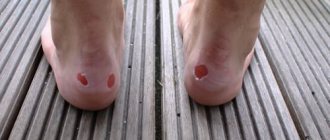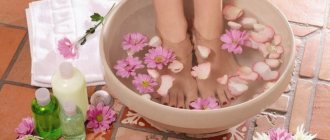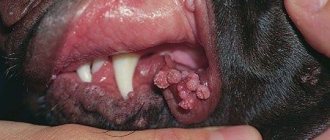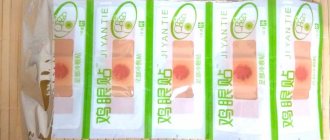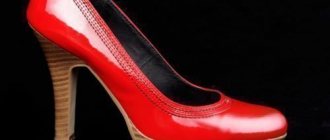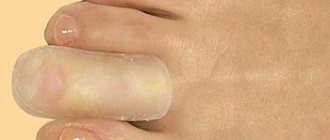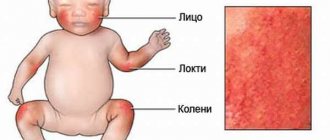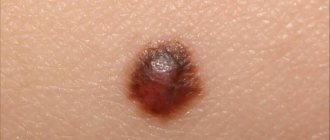What is a callus with a core?
One of the functions of the skin is protective. Seals made of horn cells protect deeper layers from damage during prolonged mechanical loads. For example, such new formations are to some extent useful for guitarists, violinists, and weightlifters. In other cases, keratinized, roughened areas provoke the formation of dry calluses. Their worst variety is core (internal, ingrown).
The neoplasms are round with a clear contour, smooth edges, yellowish in color, and small in size. Core callus gets its name from the central shaft that grows into the tissue. It is dense, painful when pressed, and has a small depression with a “plug” in the center. Calluses occur in areas of intense friction or compression of the skin. Its features:
- A difficult to treat variety with the most unpleasant symptoms. The growth does not form like a normal keratinized thickening, but grows into the deeper layers of the skin, causing severe pain.
- Dermatologists consider the growth with a shaft as the last stage of development of a dry callus.
- It differs from hard tissue by the presence of a cone-shaped, dense, cartilage-like internal rod that grows into the dermis. It is a consequence of hyperkeratosis (abnormally rapid cell division in an area of increased mechanical stress).
- When pressing, pain always occurs (intense, dull), resulting from compression of the nerve endings between the rod and the bone protrusions.
Causes
The main physiological reason for the formation of internal calluses is frequent, prolonged pressure on soft tissues. Provoke increased stress on the skin:
- Long-term wearing of narrow, hard, uncomfortable shoes, high-heeled shoes, boots with thin soles.
- Entry of a foreign body (grains of sand, shavings, small glass, splinters, other hard materials). Long-term injury to the area occurs, and the process of tissue compaction accelerates.
- The presence of old dry callus, moving into the final stage - the formation of an internal core.
- Specifics of physical exercise or professional activity:
- prolonged vertical load on the feet (athletes, loaders);
- work without gloves with hand tools (blacksmiths, carpenters, joiners);
- playing stringed musical instruments (violinists, guitarists);
- physical activity using sports equipment that causes friction on the palms and hands (horizontal bar, barbell, parallel bars);
- walking barefoot for a long time (for rural residents).
There are many factors that cause excessive pressure on certain areas of the skin. These include:
- large body weight;
- flat feet;
- viral, fungal infection;
- damage by parasitic insects (for example, scabies mite);
- skin diseases (for example, psoriasis);
- hyperkeratoses;
- age (the layer of fatty tissue in older people gradually decreases);
- hypovitaminosis (lack of vitamins);
- diabetes;
- joint inflammation;
- deformation of the toes.
Clinical picture
Individual (protruding) areas of the skin on the feet and hands experience increased mechanical stress. These are the main locations of callus localization:
- sole;
- spaces between the first and second, fourth and fifth toes;
- heel center;
- palms;
- phalanges of fingers.
A callus with a core develops gradually. Signs of its formation:
- Slight discomfort, redness of the affected area, itching, tingling are signs of the initial stage.
- The appearance of a round, convex area with a small hole in the center (an external sign of the presence of a rod) is a sign of a progressive stage.
The callus differs from the usual dry callus in its pronounced symptoms. These include:
- severe pain when pressing, walking;
- gait disturbance (when positioned on the heel, between the toes);
- redness;
- change in skin pattern;
- swelling of the affected area.
What to remember:
- You can get rid of a callus on your foot at home using soda or vinegar, but if the pathology does not respond properly to the medicine used, then it is better to seek help from a doctor.
- After removal of the rod, it is recommended to abandon high heels; shoes should be as comfortable as possible, otherwise there is a risk of recurrence of the tumor.
- If the cause of the appearance of internal growths is flat feet, then after their treatment you should wear only those shoes that the orthopedist recommends. Otherwise, calluses will become a constant headache for such a person.
- Every day, the skin of the feet must be softened with specially designed creams (Shea, Lekar) and oils (Shea, Lavender, Rosemary).
- The appearance of calluses is caused by skin diseases (fungal and viral infections), so they need to be treated in a timely manner.
Complications of callus
Pathological compactions of the epidermis (the upper layer of the skin) cannot be ignored. Calluses with a core if left untreated lead to complications:
- cause severe pain;
- provoke deep cracks in the keratinized area;
- lead to limitation or loss of performance, lameness;
- interfere with the uniform distribution of body weight, cause deformation and inflammation of the structures of the musculoskeletal system;
- with bacterial and fungal infections, rotting of the subcutaneous tissues occurs with the subsequent development of dangerous pathologies - osteomyelitis, erysipelas, phlegmon, blood poisoning.
- Treatment of prostatitis with physiotherapy
- Brazil nuts - benefits and harms for women. Properties, composition and contraindications for taking Brazil nuts
- Candles for constipation
When to see a doctor
Calluses, although they cause discomfort and inconvenience, do not automatically require a visit to the doctor. But there are cases when you should make an appointment with a therapist or dermatologist.
These situations include:
- Diabetes, heart disease or circulatory problems. If you have any of these diseases, you are at high risk of developing an infection. Possible nerve damage related to diabetes or any changes in the legs are reasons to see a doctor. (2)
- The callus secretes pus and exudative fluid. This is a sign that the callus is infected and needs immediate treatment. If inflammation spreads to the tissue surrounding the callus, this threatens the development of phlegmon or an abscess. When the bone tissue of the foot is involved in the pathological process, a person develops osteomyelitis. And also inflammation can affect the synovial membranes and articular elements of the foot.
- If calluses appear again. Only a doctor can determine why calluses keep coming back.
- If you notice that the callus has become red, especially painful or warm to the touch. These symptoms indicate a possible infection. If the callus is not treated, or you try to cut it off, but in violation of antiseptic rules, then there is a possibility of infection.
Microorganisms that enter the callus provoke inflammation. In this case, the skin growth turns red, swells, and begins to hurt greatly.
We invite you to familiarize yourself with White spots on the penis in men: photos, possible causes, treatment
Diagnostics
An experienced dermatologist determines the type of pathology through a visual examination. A callus with an internal hard core must be distinguished from a plantar wart. The latter occurs with heavy loads on the same areas of the foot. The wart is hard and painful when pressed, covered with a layer of keratinized cells, so its structure is difficult to see. This neoplasm has roots growing into the epidermis. In contrast, the core callus:
- does not bleed even at maximum pressure;
- appears as a separate growth (warts form in groups);
- it has a small depression in the center, and the wart is riddled with thin fibers. When the wart is steamed and the top layer is removed, small pinkish papillae and black dots are visible.
Diagnosis of internal callus involves laboratory blood testing. It is used to determine:
- sugar level;
- glycated hemoglobin content (in the absence of diabetes mellitus);
- titers of antibodies to papillomatosis virus, human immunodeficiency.

Causes of calluses on hands
A fairly common problem - neoplasms on the hands have several causes. This is a long-term effect on the skin in a certain place, a metabolic disorder. Physiological factors are triggered in people with weakened immune systems.
Important! From a medical point of view, education is a protective reaction of the body.
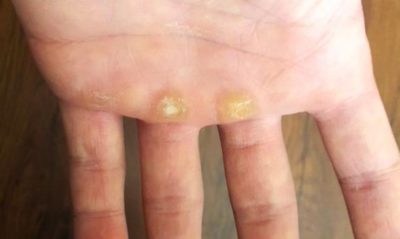
In a certain place, an additional layer of dermis begins to develop, which protects a person from external influences.
To prevent such a nuisance, before work or training, you should treat the surface of your hands with talcum powder and wear special gloves.
In order to determine how to remove calluses on your hands, you should understand the types. Experts divide skin formations according to 3 criteria - by condition, cause and location.
Treatment of dry calluses with a rod
The choice of treatment method depends on the nature of the abnormal growth on the skin. Removal of keratinized layers and complete destruction of the rod are prerequisites for complete disposal of ingrown calluses. When the central body is partially removed, the growth appears again. Self-medication is unacceptable. Growths with a rod cannot be cauterized, cut out, or treated with caustic compounds or “miracle” ointments.
Removal of dry calluses with a core is carried out physically using pharmacological drugs, salon procedures, surgery, and traditional medicine. Conditions in which removal of keratinized neoplasm is necessary:
- pain when moving and pressing;
- inflammation, swelling, redness around the growth;
- small cracks in the skin around the pathological node.
Drug therapy
The pharmaceutical action of drugs for the treatment of calluses with a core is aimed at destroying its central part, which has grown into the tissue. This is a long process. Calluses on the toes, soles, heels, and hands are removed using special plasters, ointments, and solutions. They contain substances with keratolytic action, unlike conventional patches (to protect the skin and treat wet, shallow, dry calluses and corns).
A patch for dry calluses with a rod loosens and destroys dead horn cells. The main active ingredients of the drug are salicylic (acetic, benzoic, lactic) acid and components that accelerate the process of callus destruction and have anti-inflammatory and antimicrobial effects. Removing corns with a core using special patches and ointments has a number of features:
- They can only be applied to the area of the callus itself. The acid in the drug, when it comes into contact with healthy skin, causes irritation and burns.
- Do not use on skin areas with moles, wounds, abrasions, or ulcers.
- In case of individual intolerance to the components, allergic reactions occur - itching, swelling and others.
The most popular and proven remedy is the Salipod patch based on sulfur and salicylic acid. The main active ingredients penetrate deeply into the growth, dissolve horn cells, destroy the core, relieve inflammation, and destroy pathogenic microorganisms. Rosin is one of the excipients. It has a bactericidal effect. Lanolin and rubber soften keratinized seals.
- Signs of measles in children and adults
- How to withdraw money from a mobile phone - cash out
- Kinesiology - what it is, methods and exercises at home. Applied kinesiology
Salipod is applied to the callus for 2 days. It is pre-softened in soda baths (add 1 tablespoon of soda and 2 tablespoons of grated laundry soap to 2 liters of warm water). After 2 days, the patch is removed. The callus is white; it is steamed again and carefully removed with a pumice stone. To remove the growth with the rod, you need to perform 3-6 applications. The patch should not be used by pregnant women or people taking medications for diabetes and oncology.
The pharmaceutical industry offers a wide range of callus patches with a stick. Effective and in demand are:
- Multiplast callus. Contains salicylate, sulfur, dimexide. The latter substance, in addition to its analgesic, antiseptic, and anti-inflammatory effects, improves the penetration of the active ingredients into the depths of the growth. The patch is applied to steamed, dry skin for 1-2 days. The callus is steamed again and removed. The procedure is repeated until the growth completely disappears.
- Urgo. A preparation based on salicylate and lactic acid. Apply the product once a day until a positive result is achieved. In most patients it occurs within 3-4 days.
- Compid. The product contains enzymes. Applies for several days. Actively moisturizes, softens the keratinized area, relieves pain. Use until the growth is completely destroyed.
Combined products (ointments) contain combinations of acids (salicylic, benzoic, lactic), and sulfur. They additionally contain natural components that enhance the therapeutic effect. These are celandine, plantain, castor oil, tea tree oil, beeswax, urea. After steaming the skin, medicinal compositions are applied in the form of a compress. In the list of combined agents:
- Mozolin;
- Antimozolin;
- Bensalitin;
- Doctor corn;
- Super antimozolin and others.
Special medicinal solutions have an aggressive effect on hard calluses with a core. They are not prescribed to pregnant, lactating women, or children. After steaming the skin, the solutions are applied daily to the growth and the liquid is allowed to dry. Well proven:
- Collomak (salicylate, lactic acid, fatty alcohol);
- Verrucacid (phenol, metacresol);
- Papilleque (celandine, acetic and citric acid). Apply every other day, application may be painful.
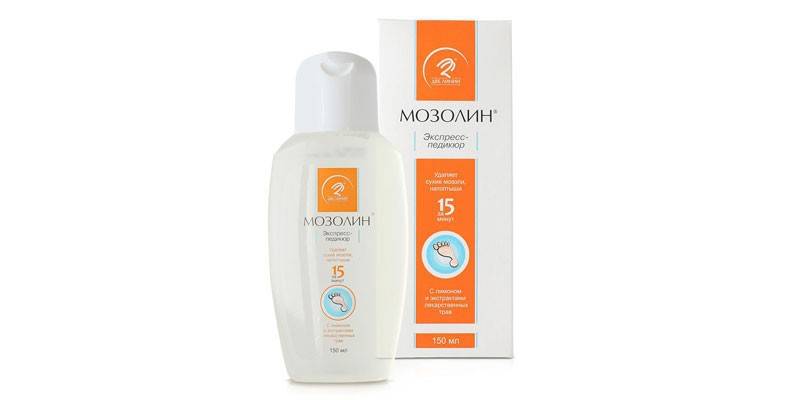
Salon treatments
Modern beauty salons have special equipment for removing rod growths. Each technique has specific implementation:
| Name | Methodology | Advantages | Flaws |
| Drilling with a drill | The keratinized layers are removed using cutters of different diameters. Instruments are selected based on the size and depth of the callus. The wound opening is treated with antibiotic ointment | Painless. After removal of the callus, the pain goes away within 2-3 days | For deep skin lesions, several procedures are required. High precision of manipulation is required so as not to damage healthy tissue. Re-infection is possible |
| Cryodestruction | The callus is treated at low temperatures (about 196°C) and destroyed. Cryoagent is non-toxic liquid nitrogen. The treated callus turns white, a bubble forms, which subsequently resolves. | The duration of the procedure is 2-4 minutes. A single procedure is required to destroy the abnormal tissue and the rod. Cold acts as an anesthetic. For deep lesions, local anesthesia (lidocaine aerosol) is used. Healing takes 10-15 days, no scars are formed. | With deep ingrowth of the central seal, the procedure is ineffective. It is difficult to regulate the depth of exposure of the cryoagent. After the formation of a bubble, there remains a risk of secondary infection (wet necrosis). Do not use for large growths due to the risk of complications. |
| Laser removal | A laser beam is used to evaporate and burn the callus. The erbium laser destroys atypical tissue. To remove build-ups from the rod, carbon dioxide (carbon dioxide) is used. It penetrates deeper into the dermis and burns out the core layer by layer under local anesthesia. The cleaned bed is treated with antibacterial compounds. The treated area is covered with a dry crust. It is strictly forbidden to tear it off - infection with pathogenic bacteria occurs, the healing process slows down, rough scars occur, and skin hyperpigmentation occurs. | The procedure lasts 5-10 minutes. One session required. Complete healing of the wound occurs in 10-14 days. The method is effective for removing old growths. Healthy tissues are not damaged, bleeding is excluded, and there is no risk of secondary infection or complications. | — |
| Radio wave method (using the Surgitron apparatus) | The growth with the rod is removed with a high-frequency radio wave electrode. Water evaporates from abnormal cells and they are destroyed. | The device does not touch the skin. Creates a precise cut without damaging healthy tissue. Painless, no bleeding, destruction of pathogenic microorganisms, rapid healing while maintaining skin elasticity. It is possible to conduct a study of abnormal tissues to exclude oncology. | — |
| Electrocoagulation (diathermocoagulation) | The callus is cauterized with alternating current. High temperature (about 80°C) destroys proteins in atypical cells, causing their death. After the procedure, a protective crust forms at the site of the growth; it disappears after 7-12 days. | Low cost of the procedure. Simplicity and efficiency. It is possible to regulate the depth of exposure to tissue. No bleeding or risk of additional infection. Histological analysis of the removed tissue can be performed. When a malignant neoplasm is detected, penetration of pathogenic structures into the general bloodstream is excluded | Pain during and after the procedure. Local anesthesia is required. There is a possibility of damage to healthy tissue. When the growth is located deeply, a scar forms during healing. High risk of relapse if not treated properly |
Operational methods of removal
In special cases, patients are prescribed surgery to remove the callus. The method is used in the following cases:
- the growths have grown very deeply;
- large areas of skin with excessive keratinization;
- drug therapy did not produce results;
- Physiotherapeutic procedures are contraindicated.
The operation involves excision of the keratinized compaction. Under local anesthesia, the layers of the growth are cut out with scissors. The rod is removed by circular cutting. The resulting wound hole is treated with antibiotic ointment. With a high level of development of hardware techniques for removing calluses, surgical excision is considered an outdated method with a number of negative effects:
- soreness;
- bleeding;
- long healing;
- high likelihood of infection.

Folk remedies
Cosmetic procedures have become popular recently. Previously, people used to get rid of keratinized lumps on the skin using traditional medicine. Removing callus at home is possible using the following recipes:
- Wash the aloe leaf, cut it lengthwise, apply it to the damaged area of skin, and secure it with a band-aid. Do the procedure at night. In the morning the growth will become soft. Using tweezers it is easy to remove the rod from it. If necessary, repeat the procedure.
- Celandine is effective against calluses at the initial stage of development. Apply freshly squeezed juice (or pharmaceutical extract) of the plant to the sore spot, and protect the surrounding skin from burns with cream. Carry out the procedure once a day. The therapeutic effect is achieved in 3-4 applications. The juice of the plant is absorbed into the affected area of the skin for about 5 minutes.
- Prepare a mixture of garlic and onions, grate them on a fine grater. Wash the growth with soap, steam it, put the prepared paste on it, and secure it with a bandage. Do the procedure at night for 10-15 days. The growth with the rod will disappear during this time.
- Warm pitted prunes well in milk. Place hot dried fruit on the callus. After cooling, replace it with a new one. Warm up with prunes for 45 minutes for several days until the callus completely disappears. The procedure is effective for removing shallow growths.
- Mix 1 teaspoon of honey, the same amount of grated radish, 10 drops of tea tree oil. Steam the growth and protect the surrounding skin with a bandage. Apply a thin layer of honey mixture to the sore spot and cover with a bandage. Do the procedure at night for several days until the callus completely disappears.
Traditional methods of treatment
You can get rid of newly appeared calluses using home remedies, and most often these are the substances that every housewife has in her kitchen.
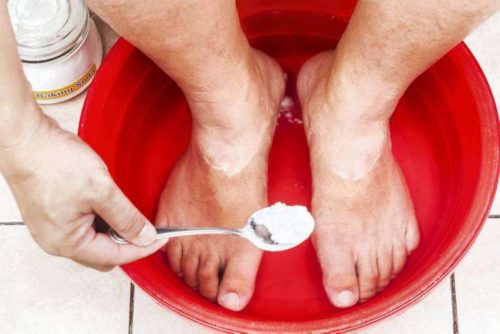
Burn the rod with vinegar
How to prepare: Mix 1 part white vinegar and 3 parts water.
How to use: Soak a tampon in the prepared mixture, apply it to the callus, secure with a bandage. In the morning, exfoliate the softened skin with pumice stone and moisturize with olive oil. Carry out the treatment procedure every night.
Result: High concentration of acid helps soften dead skin layers. The antimicrobial properties of the product reduce the risk of wound infection. The rod comes out within 7 days.
Baking soda
Baking soda quickly removes the layer of dead cells from your skin. It has an antimicrobial effect, which helps prevent infection of the wound formed after removal of the rod. Below are two options for using food grade alkali to combat different types of calluses.
First option
How to prepare: Dissolve 2-3 tbsp. l. soda in warm water.
How to use: Soak your feet in the soda solution for 10 minutes. Remove the softened skin with a pumice stone. Carry out the procedure every day.
Result: The root of the callus comes out within 10 days, the wound heals within 3-5 days.
Second option
How to prepare: Mix 1 tsp. baking soda with lemon juice and water (the consistency of the prepared composition should resemble a thick paste).
How to use: Before going to bed, apply the mixture to the affected area and fix. In the morning, wash your feet in warm water and carefully remove dead skin with a pumice stone. Use daily.
Result: The callus core comes out within a week. After which the wound heals for about another 3-5 days.
Lemon juice
Another good home remedy for subcutaneous tumors is lemon juice. The acid of this fruit helps soften the hardened callus and pulls its core out.
How to prepare: Squeeze juice from 1-2 lemon slices (the amount depends on the size of the affected skin).
How to use: Rub the juice onto the affected area and let it dry. Repeat treatment at least 3 times a day. Every time you wash your feet, remove the exfoliating layer with a pumice stone.
Result: The callus core comes out within 7-10 days.
Cloves with lemon
Ingredients:
- Cloves (spice) - 2 pcs.
- Lemon juice - 1 tbsp.
How to prepare: Put the spice in the juice, let it brew for 15 minutes.
How to use: Rub the liquid into hardened skin. After drying, repeat the procedure. Carry out treatment daily (3-5 times a day) until recovery.
Result: The root of the callus is burned out within 7 days; thanks to the properties of cloves, the wound heals faster.
Castor oil
How to prepare: Soak a cotton ball in castor oil.
How to use: Before going to bed, soak your feet in hot water at a comfortable temperature, carefully remove dead skin with a pumice stone. Rinse your feet with clean water and wipe dry. Apply a compress to the callus, secure with a band-aid, and leave overnight. In the morning, remove the bandage. If possible, rub castor oil into the sore spot throughout the day.
Result: Castor oil burns the callus core within 10 days, helps relieve pain, and accelerates the healing of the damaged area of skin.
Celandine is often used to remove warts, but it can also be used to treat calluses. But, of course, he won’t get rid of them completely. Complex treatment is needed.
Prevention
The formation of keratinized tumors on the skin is easier to prevent. To do this, you need to adhere to basic rules:
- treat dropsy in a timely manner;
- use the recommended means to prevent the transition of an ordinary hard callus into a core form;
- carefully select everyday shoes, they should be as comfortable as possible;
- choose socks, knee socks, stockings according to size, giving preference to products made from natural materials;
- use remedies for excessive sweating of the feet;
- when working with hand tools, wear comfortable gloves; when performing physical exercises on exercise machines, treat your hands with talcum powder;
- while bathing, remove dead skin layers with a pumice stone;
- Treat areas of hardening and abrasions with nourishing, moisturizing creams;
- Apply prophylactic plasters to areas where shoes rub;
- insert orthopedic insoles into shoes to evenly distribute the load and provide full shock absorption;
- maintain normal body weight, treat obesity;
- The menu includes carrots, cream and other foods high in vitamins E, A, B to maintain good skin condition.
The use of folk remedies
- Onion and garlic. First, rough hands are immersed in a warm solution with dissolved soda for a quarter of an hour. Dissolve a little soap and a small spoon of soda in one liter of warm water. Then softened onion or garlic is applied to the softened calluses. It is necessary to carry out 12 procedures to cure even the hardest calluses. Instead of onions and garlic, you can apply a fresh aloe leaf to the callus.
- Plantain. You can apply a clean fresh plantain leaf to the callus or lubricate it with fir oil.
- Celandine. Celandine is used to treat calluses. Fresh juice from the plant is used to lubricate calluses in the morning and evening. This very effective remedy helps for five days.
- Propolis. Heated propolis is applied to hands steamed in warm water. Then the affected areas are sealed with a bactericidal plaster.
But it is better not to allow calluses to appear on your hands. To do this, any physical work must be done with gloves.
calluses always cause discomfort and a desire to get rid of them as quickly as possible.
But often people resort to the wrong methods of getting rid of calluses.
But before treatment, you should understand its type and cause of its appearance.
In the article we will look at what a callus is, as well as their types.
In addition, we will tell you which doctor to contact for help and about methods of treating calluses.
Reasons for the formation of calluses on the finger
Dry crusts or wet blisters may appear on the skin under the influence of negative external and internal factors. The process is not always directly related to an increase in the intensity of physical labor.
The selection of a course of treatment should be made only after determining the cause of the development of the clinical picture in a negative way. Calluses on the fingers appear under the influence of the following factors:
- Excessive physical activity negatively affects the condition of the skin. Calluses are a consequence of active sports, doing housework, repairs or construction. Against this background, growths with lymphatic fluid often occur.
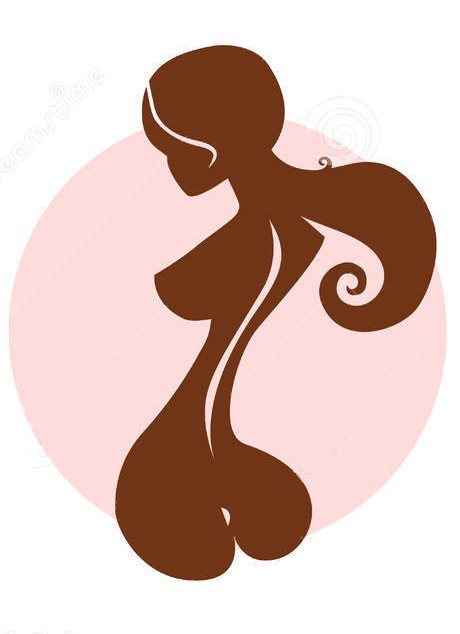
How to get rid of calluses on your fingers, watch this video:
The callus must be correctly identified.
Only after this will the dermatologist be able to choose the right course of treatment. Today in medical practice, education is differentiated into the following types:
- A large amount of fluid accumulates inside the dropsy. They occur due to excessive physical activity or friction. After a few days, the callus ruptures and after that the stage of active healing of the skin begins.
- Dry callus is the result of moderate friction. Thanks to him, the skin tries to rid itself of injury. They are much more difficult to eliminate than the previous type.
- The rod is characterized by the presence of a root that penetrates deep into the skin. The lesion is serious and requires immediate surgical removal.
Thanks to the qualified help of a doctor, you can quickly get rid of calluses:
- The rod formation is eliminated by drilling, laser burning, cryodestruction or electrocoagulation.
- Only a surgeon can help eliminate a purulent callus. Without timely assistance, the risk of developing suppuration increases.
Any pharmacy offers a wide range of medications that will help get rid of the blister within a few days. During the treatment process, you should adhere to a number of simple rules:
- A weeping blister is dangerous due to the increased risk of spreading a secondary infection. Treatment with an antiseptic (hydrogen peroxide, furacilin, chlorhexidine) will help prevent its development. The use of antibacterial ointments (levomekol, liniment, syntomycin) is allowed.
This video will tell you how to treat calluses:
To remove calluses, you can also use all-natural ingredients. Most often, aloe juice is used for this. The leaves of the plant are peeled and crushed.
The resulting composition should be applied to the affected area. Swelling, pain and inflammation disappear within a few days. Additionally, the process of natural tissue regeneration starts.
Aloe juice helps destroy harmful bacteria and microorganisms.
To eliminate calluses and the consequences of their formation, it is recommended to use one of the following traditional medicine methods:
- Celandine juice helps get rid of many skin diseases. Calluses and warts are no exception. It is recommended to apply the composition to the affected surface once a day.
- Aloe helps not only relieve inflammation in wet blisters, but also soften the upper part of the epidermis in dry ones. Regular use guarantees painless removal of keratinized tissue.
- Chopped garlic helps get rid of calluses. The resulting composition is best applied to the affected area at night.
- To nourish and moisturize the skin, it is recommended to use calendula compresses. To prepare the healing composition, it is recommended to use exclusively the flowers of the plant.
- Propolis has a positive effect on the condition of the skin. Before use, it must be warmed well and wrapped in gauze. To secure it, you should use a regular plaster.
- A bath of soap and soda helps soften rough areas.
When using traditional medicine methods, one should not forget that they can cause an allergic reaction. Most often, individual intolerance in people is fixed to honey and herbal components.
Before starting any procedure, you need to apply a small amount of the composition to the crook of your arm.
The method should be abandoned if there is redness or burns. The abuse of organic acids is also dangerous. Excessive amounts of acetic or citric acid can leave a mark on the skin.
When using them, you must strictly adhere to the dosage indicated in the recipe. Otherwise, the risk of complications, scars and burns increases. They can remain on a person's skin for life.
Which doctor treats it and where to remove it?
A dermatologist is involved in the treatment of ingrown callous growths; the doctor will prescribe tests to exclude a viral or fungal origin of the growth. Removal takes place in a cosmetologist's office; medicines and folk remedies are used at home independently.

To treat callus, consult a dermatologist
With strong palpation of the callus, an intense attack of dull pain always occurs - the nerve endings compress the root.
Causes and symptoms of inflammation
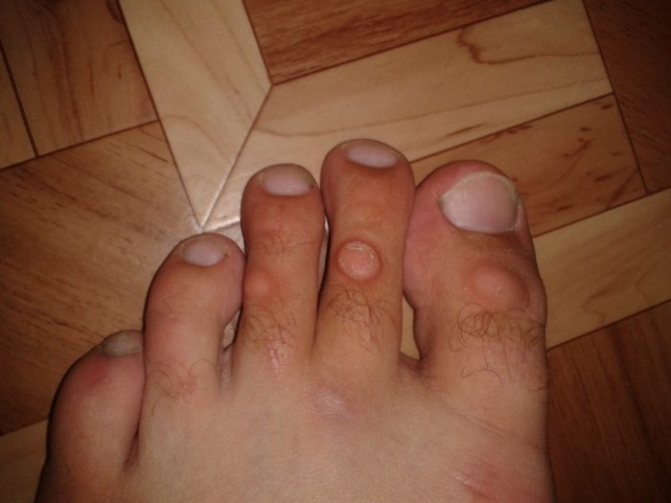
A callus causes a lot of anxiety to a person, and when an inflammatory process occurs, the discomfort increases several times. In most cases, the causes of inflammation are due to the actions of the patient.
Fact: a watery callus interferes with walking and comes into contact with shoes, resulting in pain. What does the majority do in this case? It pierces the element or, even worse, tears off the skin. As a result, the liquid leaves, and the illusion of solving the problem is observed. But that's not true. An adverse reaction is not long in coming. An open wound is a direct route for infection, which leads to inflammation.
Thus, the main cause of inflammation of the callus is the mechanical actions of the person himself. The same can be said about dry tumors. Many patients try to cope with the problem on their own, steaming the limb, rubbing with a pumice stone, a nail file, or picking at the formation with scissors. All this leads to injury and, accordingly, inflammation.
When a bacterial infection enters the wound, the callus can fester. Purulent processes occur with both wet and dry calluses. During hygiene measures, people forget about the use of an antiseptic solution and other disinfection measures, including instruments.
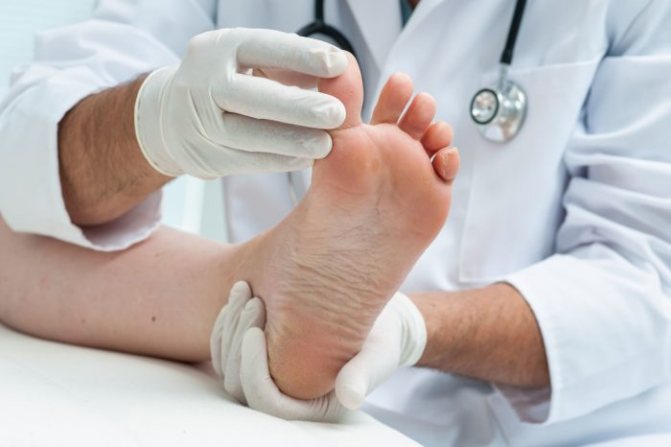
If a callus on your toe becomes inflamed, it is recommended to see a dermatologist. In the absence of timely and adequate drug treatment, serious consequences can develop - embolism, sepsis, and in advanced cases, gangrene.
Clinical manifestations of callus inflammation:
- The exudate that fills the callus or corns has a cloudy color. Normally, it should be colorless or have bloody impurities. A change in color indicates a worsening of the clinical picture.
- The appearance of inflamed calluses is often accompanied by a feeling of pulsation or swelling in the affected area.
- Painful sensations. It hurts to walk, to step on the sore leg.
- In the presence of a purulent process, a yellow exudate is released from the callus, characterized by an unpleasant odor.
- The corns become red, and the surrounding skin also turns red. If swelling appears, this indicates a severe degree of inflammation.
- The affected area may itch, and local body temperature increases.
Improper removal of dry callus with a core at home leads to negative consequences. Without experience, it will not be possible to remove all roots. A person, trying to solve an impossible task, only makes things worse for himself, while the desired effect is absent.
In some clinical pictures, against the background of severe inflammation of the little finger or other toes, the patients’ general health worsened - body temperature increased, weakness and nausea were observed. If nothing is done at this stage, the entire leg will soon swell.
